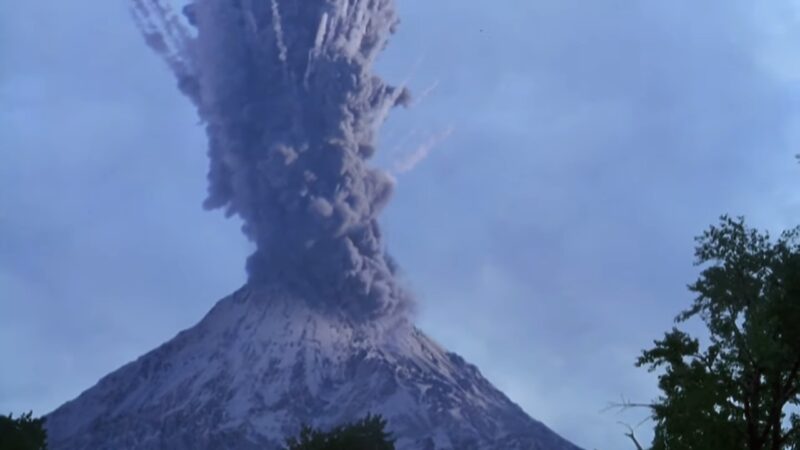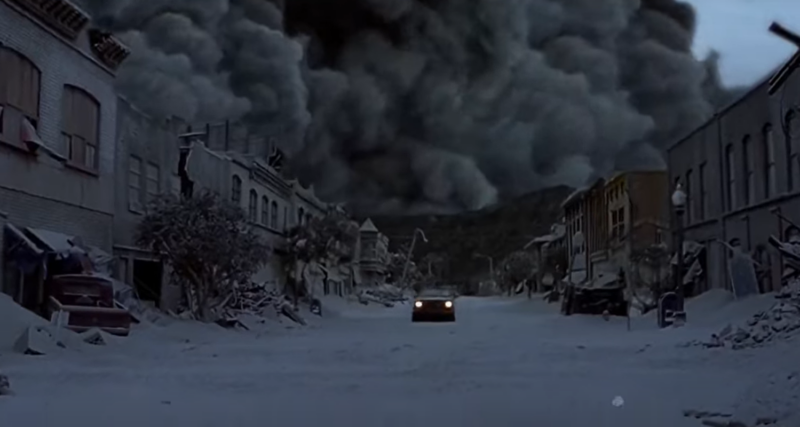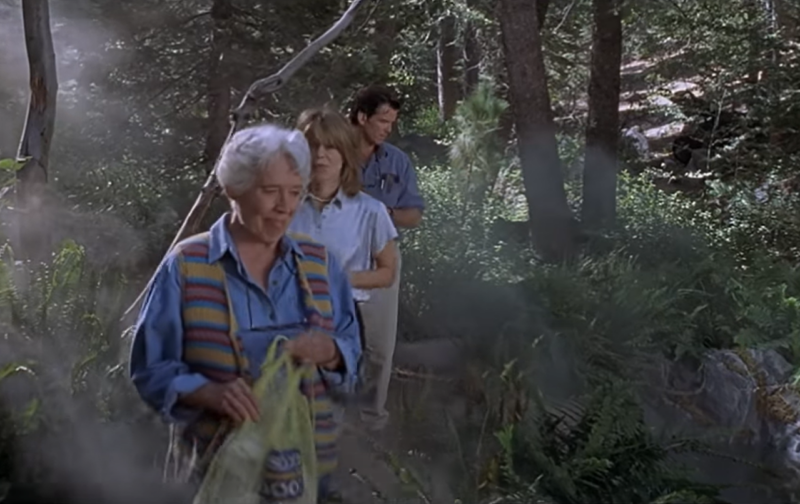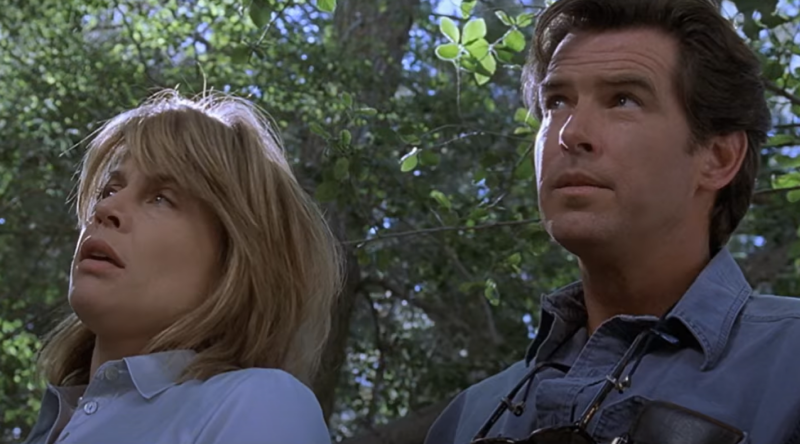Movie buffs!!!
Ever watched the 1997 disaster film “Dante’s Peak”? Directed by Roger Donaldson and starring the dashing Pierce Brosnan and the talented Linda Hamilton, this film took us on a thrilling journey through the fictional town of Dante’s Peak.
But what truly made this film stand out were its breathtaking filming locations. The right backdrop can elevate a movie from good to unforgettable, and “Dante’s Peak” is a testament to that.
Fun Fact: The film was released under the production of Universal Pictures and Pacific Western Productions.
Setting the Scene

The story revolves around USGS volcanologist Harry Dalton, played by Pierce Brosnan, who is sent to investigate seismic activity near Dante’s Peak, Washington. The town is nestled beside a dormant stratovolcano, which, spoiler alert, doesn’t remain dormant for long.
As Harry gets to know Mayor Rachel Wando and her family, they uncover signs of an impending eruption. The film beautifully intertwines the suspense of a natural disaster with personal relationships, making it a gripping watch from start to finish.
Pro Tip: If you’re a fan of disaster films, the natural disaster theme in “Dante’s Peak” is a must-watch!
Choosing the Ideal Backdrop
The process of scouting and selecting the perfect filming location is no easy feat. For disaster films like “Dante’s Peak”, authenticity is paramount. The audience needs to believe in the setting to truly feel the tension and drama.
And let me tell you, the locations chosen for this film did not disappoint. From the real-life town of Wallace, Idaho, to the majestic landscapes of the Pacific Northwest, every location added depth and realism to the narrative.
Fun Fact: The film was shot on location in Wallace, Idaho, and even used exterior shots of the Point Dume Post Office in Malibu, California!
Exploring the Real-Life Town
Wallace, Idaho, played a pivotal role in bringing the fictional town of Dante’s Peak to life. This charming town, with its unique features and atmosphere, was the perfect choice to portray a community on the brink of a volcanic disaster. As you watch the film, you can’t help but feel connected to Wallace and its inhabitants, rooting for their safety and survival.
Pro Tip: If you’re ever in the Pacific Northwest, consider taking a detour to Wallace, Idaho. Experience the town that played such a crucial role in “Dante’s Peak” and soak in its rich history and beauty.
Capturing the Landscapes

The Pacific Northwest, often referred to as Cascadia, is a breathtaking region in western North America, bordered by the Pacific Ocean to the west and the Rocky Mountains to the east. This region encompasses the U.S. states of Oregon, Washington, and Idaho, and sometimes even the Canadian province of British Columbia.
Fun Fact: The Pacific Northwest is sometimes confused with the Northwest Territory or the Northwest Territories of Canada. However, the term “Pacific Northwest” specifically refers to the coastal region of northwestern North America.
The landscapes here are dominated by several mountain ranges, including the Coast Mountains, the Cascade Range, and the Olympic Mountains. The highest peak in this region is Mount Rainier, standing tall at 14,410 feet, making it a sight to behold.
Pro Tip: If you’re a hiking enthusiast, the Pacific Northwest offers some of the best trails. Don’t miss out on the Mount Rainier trails if you’re looking for a challenging yet rewarding experience.
Facing the Elements
Filming in the Pacific Northwest, with its diverse landscapes, is no easy feat. The region is geologically active, with active volcanoes and geologic faults. The last known significant earthquake in this area was the 1700 Cascadia earthquake. Such geological activities pose challenges for film crews, from ensuring the safety of the equipment to the well-being of the cast and crew.
Fun Fact: Active volcanoes in the region include Mount Garibaldi, Mount Baker, Mount St. Helens, and Mount Hood, among others.
Safety precautions are paramount. Filming near active volcanoes or geologically sensitive areas requires constant monitoring and collaboration with local geological experts. The unpredictable weather, especially in coastal regions, can also play spoilsport, leading to delays and rescheduling.
Transforming Reality into Fiction
While the Pacific Northwest offers stunning natural backdrops, the magic of cinema often requires a blend of practical and digital effects to bring a director’s vision to life. For disaster films like “Dante’s Peak,” the real challenge lies in making the sequences look realistic yet spectacular.
Practical effects, such as controlled explosions or water sequences, are often shot on location. Later, visual effects teams enhance these sequences digitally, adding layers of detail and magnitude that might be too dangerous or impossible to capture in reality.
Pro Tip: Next time you watch a disaster film, try to spot the seamless blend of practical and digital effects. It’s an art in itself!
Immersion Through Authenticity

There’s a reason why filmmakers often choose real locations over studio sets. Authenticity. When audiences see real landscapes, towns, and landmarks, they feel more immersed in the story.
The Pacific Northwest, with its unique blend of coastal beauty, dense forests, and majestic mountains, offers that genuine feel which is hard to replicate. Iconic scenes, when shot in such authentic locations, leave a lasting impact, making the movie memorable.
Fun Fact: The Pacific Northwest forests are among the most lush in North America, with the Coast Douglas fir trees being the second tallest growing evergreen conifer on earth.
In “Dante’s Peak,” the choice of real locations added depth to the narrative, making the impending disaster feel all the more real and imminent. The audience could connect with the characters, understanding their love for their town and the dread of the looming catastrophe.
Pro Tip: If you’re an aspiring filmmaker, always weigh the pros and cons of shooting on location versus a studio. Sometimes, authenticity can elevate your story to new heights.
Beyond the Silver Screen
“Dante’s Peak” not only entertained audiences worldwide but also left an indelible mark on the Pacific Northwest, especially in places like Wallace, Idaho. The film’s release turned the spotlight onto these serene and picturesque locations, making them popular tourist destinations. Fans and movie enthusiasts flocked to these sites, eager to experience the real-life settings of their favorite disaster film.
Fun Fact: Wallace, Idaho, saw a surge in visitors post the film’s release, with many wanting to walk the same streets as Pierce Brosnan and Linda Hamilton.
Recreating the Experience
Film tourism, where fans visit filming locations of their favorite movies, has been a growing trend over the years. “Dante’s Peak” is no exception. The movie’s authentic portrayal of the Pacific Northwest has drawn fans from all over the world.
These visits offer fans a deeper connection to the film, allowing them to relive iconic scenes and moments. From the serene Mirror Lake, where Grandma Ruth’s lakeside house was depicted, to the majestic landscapes of Mount St. Helens National Volcanic Monument, fans can immerse themselves in the world of “Dante’s Peak.”
Pro Tip: If you’re planning a trip to the Pacific Northwest, consider adding these filming locations to your itinerary. It’s a unique way to experience the magic of cinema in real life.
FAQ
Who directed “Dante’s Peak”?
The film was directed by Roger Donaldson.
Were any animals featured in the film?
Yes, the movie had scenes with animals, including a memorable one involving a dog during the eruption sequence.
How long is the runtime of “Dante’s Peak”?
“Dante’s Peak” has a runtime of approximately 108 minutes.
Were there any sequels or spin-offs made after “Dante’s Peak”?
No, “Dante’s Peak” is a standalone film and did not have any sequels or spin-offs.
Final Words
“Dante’s Peak” is more than just a disaster film. It’s a celebration of the Pacific Northwest’s natural beauty. The film’s success in capturing the essence of this region ensures that its stunning settings remain etched in the memories of viewers for years to come.
As we reflect on the film’s legacy, it’s evident that the right filming locations can transform a movie into a timeless masterpiece. Here’s to the enduring charm of “Dante’s Peak” and the awe-inspiring beauty of the Pacific Northwest!
Fun Fact: The film’s depiction of the volcanic eruption, while fictional, drew inspiration from real-life events, such as the 1980 eruption of Mount St. Helens.
And with that, we wrap up our journey through the filming locations of “Dante’s Peak.” Whether you’re a movie buff, a nature enthusiast, or someone who appreciates the art of cinema, there’s no denying the magic that unfolds when a compelling story meets the perfect backdrop. Until our next cinematic adventure, keep exploring and stay curious! 🎬🌋
